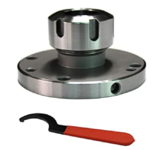NT_2112
Member
Hi all.
Please take a look at the video.
Would a drawbar help reduce the wobble?
Is this excessive run out?
Would I be better off with a mounting a plate style collet chuck using bolts like the 3 jaw chuck?
Thank you for your time.
Please take a look at the video.
Would a drawbar help reduce the wobble?
Is this excessive run out?
Would I be better off with a mounting a plate style collet chuck using bolts like the 3 jaw chuck?
Thank you for your time.

